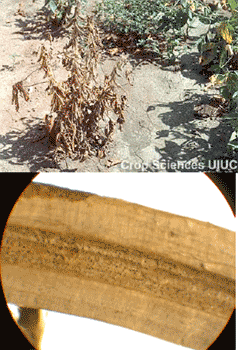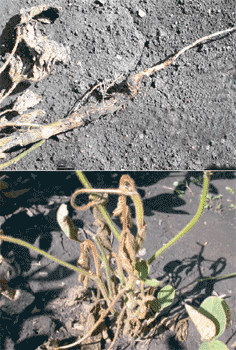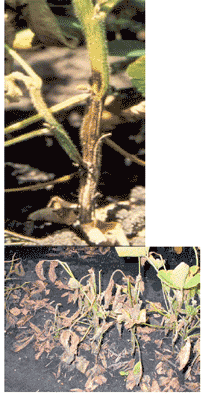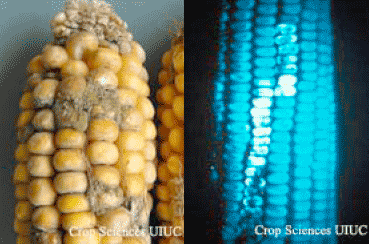Interactions Between Weather and Crop Disease
 |
Dean MalvickAssistant Professor of Plant Pathology and Extension SpecialistPhone: (217) 265-5166 E-mail: dmalvick@illinois.edu |
||
If you don't like the weather now, just wait and it will change soon in Illinois. Likewise, if a crop disease has not been a problem recently, just wait until next year. When and where diseases damage crops is highly dependent on the weather. This may not always be obvious, as we may have seen in 2003, and there are a multitude of different interactions between weather and crop disease that can occur. We cannot know which disease will be a problem next year, but we should always be aware of potential disease problems and follow a scouting plan based in part on weather conditions to detect problems when they arise.
Crop Disease: What Does Weather Have to Do With It?
This question can be answered with a few basic concepts related to the biology of interactions between weather and crop disease. These interactions go in both directions. Environmental conditions can promote disease, and disease can exacerbate the effects of stressful weather conditions. There are at least three general patterns.
-
Certain weather patterns promote pathogen activity, infection, and disease damage. This is the most obvious interaction. For example, wet and humid weather increases most foliar fungal and bacterial diseases of field crops such as gray leaf spot and anthracnose leaf blight of corn, Septoria brown spot and bacterial blight of soybeans; and cool and wet weather promotes white mold of soybeans.
-
Disease can increase plant stress under taxing environmental conditions; for example, root diseases can intensify the effects of very dry conditions to result in water-stressed crops, and stalk and root rots increase the effects of wind on lodging.
-
Plant stress can make plants more susceptible to crop diseases; for example, hot and dry weather favors charcoal rot of soybeans and Aspergillis ear rot of corn.
All of these types of interactions occurred in Illinois soybean and corn fields in 2003, and some examples are described in the following sections.
Charcoal rot of soybeans
Increased by hot, dry weather
Charcoal rot was widespread in Illinois in 2003. Charcoal rot infections can begin in the spring with wet soil conditions, but the disease causes most damage later in the season when weather is hot and dry, and soil temperatures are greater than 80oF. The most seriously affected areas are often in the drier parts of fields. Leaves of severely infected plants turn yellow and brown, wilt, and remain attached to the plant. Plants infected with charcoal rot have gray/black specks called microsclerotia that appear similar to scattered bits of charcoal dust on or under the epidermis of the root or lower stem. The specks are difficult to see without the help of a hand lens. Also, there are often distinct, wavy gray to black streaks inside the root and lower stem. Many plants with charcoal rot in central Illinois this year also had rotted roots.
The fungus (Macrophomina phaseolina) that causes charcoal rot is a pathogen that some reports suggest is weak by itself and may cause minimal damage when plants are not stressed. But it can severely damage soybeans by causing root rot and infecting the vascular system when plants have been subjected to hot, dry weather and other stresses. Charcoal rot can be a secondary disease that takes advantage of hot weather and weak plants. Charcoal rot is a difficult disease to manage. Some cultivars have been reported to be less affected by charcoal rot than others, but none are resistant.
Root rot and top dieback of soybeans
May have increased with wet weather
Soybeans in central Illinois in July 2003 were widely damaged or killed soon after heavy rains saturated soils in the region. This disease problem occurred where water was standing and in parts of fields that were moderately-well drained. The most obvious symptom was necrosis and wilting of the top of the plants. Additional symptoms were root rot, sloughing off of the root epidermis and cortex, red discoloration of the root where the sloughing-off had occurred, and absent and rotted Rhizobia nodules. The leaf and stem symptoms soon subsided, and some plants seemed to recover, but many plants had root rot.
It was suggested at that time that the root rot associated with this disease problem may continue to stress plants, especially if the soils became dry later in the summer. To some extent, this appears to have happened. Many soybean plants brought to the UIUC Plant Clinic in Urbana for diagnosis had root rot, and root rot was common in soybean fields in September at many Illinois locations. The cause for the root rot problems is complex and unclear. Fusarium, Phytophthora, and Pythium were associated with the root rot in July, but the roots on plants later in the season were generally too old and rotted for diagnosis. The effect of this root rot problem on soybean yields in 2003 is not clear, but it may have been significant.
Phytophthora and Pythium rot of soybeans
Increased by wet weather in spring
Soil conditions are frequently favorable for damage to soybeans caused by Phytophthora and Pythium in the spring. These two pathogens cause similar seed rot and pre- and post- emergence damping-off of seedlings. Pythium is usually favored by cool, saturated soil conditions, and Phytophthora is favored by warmer and intermittently wet soil conditions—conditions that existed across much of Illinois in spring 2003. Unlike Pythium, which causes most damage early in the spring, Phytophthora rot can kill plants well into August.
Both pathogens can be managed in part by using seed treatments such as metalaxyl (e.g. Allegiance) or mefenoxam (e.g., Apron XL) and by improving drainage if possible. Resistant varieties with specific resistance are also used to manage Phytophthora rot of soybean. We have recently confirmed that the major resistance (Rps) genes are no longer effective in some parts of Illinois. Races (pathotypes) of Phytophthora occur in parts of Illinois that kill soybeans with Rps1a, Rps1c, and Rps1k. Many of the Phytophthora isolates from Illinois soybean fields can defeat Rps1a, and a smaller number can defeat 1c and 1k. Some can defeat all of the common resistance genes (Rps 1a, 1c, and 1k) that are available in commercial varieties for Illinois.
We still do not know how widespread the aggressive isolates are in Illinois or how much damage they are causing. This demonstrates that if there is wet weather in the spring after planting, Pythium can cause stand losses, and Phytophthora rot can cause widespread damage to soybean varieties with the best resistance genes currently available.
Aspergillis and Fusarium ear rots and mycotoxin production in corn
Increased by hot, dry weather
Corn ear and kernel rots are common in some years in Illinois. Two types that produce potent mycotoxins and are most severe when weather is hot and dry after mid-season are Aspergillis ear rot and Fusarium ear and kernel rot. These produce the mycotoxins aflatoxin and fumonisin.
Aspergillis infection is noted as patches of green to yellow spores on or between kernels, and is most common at the tips of ears and scattered on a few kernels on the ears. The fungus can become dark green to brown as it ages. Aflatoxin seems to be produced in greatest quantities under drought conditions. Fusarium fungal growth is most often found at the ear tip. Infected kernels may be scattered on the ear and be covered with a whitish pink fungal growth, or infected kernels may develop a "starburst" symptom, which is seen as white lines radiating out from a point on the kernel. Kernels can also be infected at the embryo end, and symptoms may not be visible. Symptoms may vary according to the genotype of the corn hybrid, weather, or disease severity. Fumonisin production is favored by hot, dry conditions and high humidity.
Most commercial hybrids have minimal resistance to these ear rot diseases. Irrigation and management of insects that damage ears may help reduce these problems.
Crop Scouting and Summary
Weather has a dramatic effect on occurrence, distribution, and severity of many corn and soybean diseases. Likewise, crop diseases can increase the effects of weather-induced crop stress, especially hot and dry conditions. As can be seen from the examples above, many different weather-related scenarios result in disease, and most weather conditions favor one disease or another. Thus, weather conditions shouldn't dictate if you scout your fields, but they can dictate which diseases or other pest problems to focus on when scouting.
This presentation is meant to illustrate some of the many interactions between weather and plant diseases. We often see that wet or humid conditions result in more disease, but it may not be obvious that disease can dramatically increase the negative effect that weather has on yield.
The following scenario may explain part of the reduction in soybean yields in some parts of Illinois in 2003. Wet weather in spring may have increased charcoal rot and other root-rot infections, and heavy rains in July may have further promoted widespread root-rot and reduced Rhizobia nodulation. Following this, when the dry and hot weather came in August, the charcoal rot developed, and yield damage from drought stress was increased due to partially rotted root systems.
The interactions between weather and disease are complex. However, this is a narrow picture relative to the many other interactions that occur with factors including weeds, insects, and soil nutrients.
Tables & Figures
 |
Figure 1. Charcoal rot and microsclerotia
of the charcoal rot fungus on a soybean stem. |
 |
Figure 2. Root rot and top dieback
of soybeans in 2003. |
 |
Figure 3. Phytophthora rot of
soybean. |
 |
Figure 4. Aspergillis ear rot
and black light test for aflatoxin |